Structural shifts in the financial markets have led to interesting strategic shifts among hedge fund managers. Although the hedge fund business is merely an enclave of the financial markets, its activities provide valuable insights to market participants.
Hedge fund trades fuel any investment analysis; however, they should be placed into perspective. For those unaware, hedge funds rely on active strategies that assume short-term horizons. Moreover, hedge funds reveal their positions after the fact, meaning their portfolio alterations are communicated months after implementation. As such, investors should not look at hedge fund positions in isolation but instead consider them as part of a holistic analysis.
With the aforementioned considered, here are three stocks hedge funds are selling en masse.
Lowe’s Companies (LOW)

According to its latest 13f filing, Bill Ackman’s Pershing Square sold $83.6 million worth of LOW (NYSE:LOW) stock in its third quarter. LOW stock is up by more than 10% since the turn of the year. However, Ackman’s investment fund somehow believes the stock is overvalued.
The Michigan Consumer Sentiment indicator showed that U.S. consumer sentiment surged by roughly 13.7% in November. Moreover, U.S. personal income is growing steadily. As such, I’m not quite sure that top-down variables align with Ackman’s outlook.
Despite top-down variables supporting a bullish case for Lowe’s, the company possesses a few idiosyncratic concerns, possibly explaining Ackman’s bearish call on LOW stock. The firm released its third-quarter earnings report last month, revealing a revenue miss of $390 million. Furthermore, organic growth is slowing as comparable sales have decreased by 7.4% year-over-year.
The company’s latest financial results place LOW stock’s price-to-earnings ratio at 24.08x, which isn’t compelling at all. Even though I think this stock is a Hold instead of a Sell, Ackman’s bearish case has a reasonable basis. In addition, Goldman Sachs (NYSE:GS) stated earlier this month that LOW stock is shunned by numerous hedge funds, suggesting a uniform outlook exists within the hedge fund manager sphere.
Expedia Group (EXPE)

Michael Burry’s Scion Capital disposed of $620 000 Expedia (NASDAQ:EXPE) shares in its third quarter. In addition, according to my calculations, passive investor, Vanguard Group concurrently dumped $57.27 million worth of EXPE stock, adding to a bearish narrative.
Investment decisions aren’t homogenous among investors. Therefore, it would be unfair of me to guess why Burry and Vanguard sold EXPE stock. However, my own analysis tells me that various quantitative-driven funds could be concerned about EXPE stock’s technical features. For example, EXPE stock’s put-call ratio has slid past one, suggesting bearish sentiment has emerged. In addition, EXPE stock’s near 80% year-to-date gain has sent its relative strength index to 75.61, suggesting EXPE stock is overbought.
Expedia’s fundamental stealth contradicts Burry and Vanguard’s outlook. The company delivered robust results in its third quarter by surpassing its revenue and earnings-per-share targets by $70 million and 41 cents, respectively. Moreover, Expedia has embarked on a fresh $5 billion share buyback program to lower its investors’ cost basis. Expedia’s buyback program, paired with its forward price-to-earnings-growth ratio of 0.3x, indicates that we are looking at a decent stock here, which is why I dispute Michael Burry’s bearish outlook.
Occidental Petroleum (OXY)

OXY (NYSE:OXY) stock is a Warren Buffet favorite, spanning 4% of Berkshire Hathaway’s (NYSE:BRK-A,NYSE:BRK-B) portfolio. However, short interest on OXY stock has reached 7% of its market capitalization, suggesting numerous active managers are bearish.
Among a few alternative asset managers that recently disposed of OXY stock are Alpine Global Management, POINT72 Middle East, and WorldQuant Millenium Advisors. A mass exodus from OXY stock has unfolded, which makes sense as a cyclical inflection point has emerged.
The inflection point I’m referring to refers to top-down variables. Occidental Petroleum faces waning industrial production in the U.S. and Europe, which raises demand concerns. Although a recent shift in U.S. consumer sentiment and improving China PMI numbers can phase out demand-side risks, industrial production often lags consumer sentiment, raising concerns about the near-term prospects for petrochemical sales.
Furthermore, OXY stock’s valuation suggests its stock price has yet to reflect its fundamental worth. For instance, OXY stock’s forward price-to-book ratio of 2.56x is at a 5-year premium of 23.75%. Additionally, OXY stock’s forward price-to-earnings ratio of 15.01x is at a 53% premium to its 5-year average. Therefore, I would not be surprised if an interim stock drawdown occurs, especially considering the aforementioned top-down variables.
On the date of publication, Steve Booyens did not hold (either directly or indirectly) any positions in the securities mentioned in this article. The opinions expressed in this article are those of the writer, subject to the InvestorPlace.com Publishing Guidelines.
